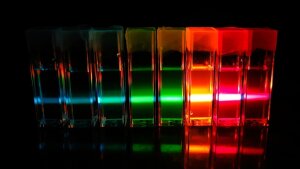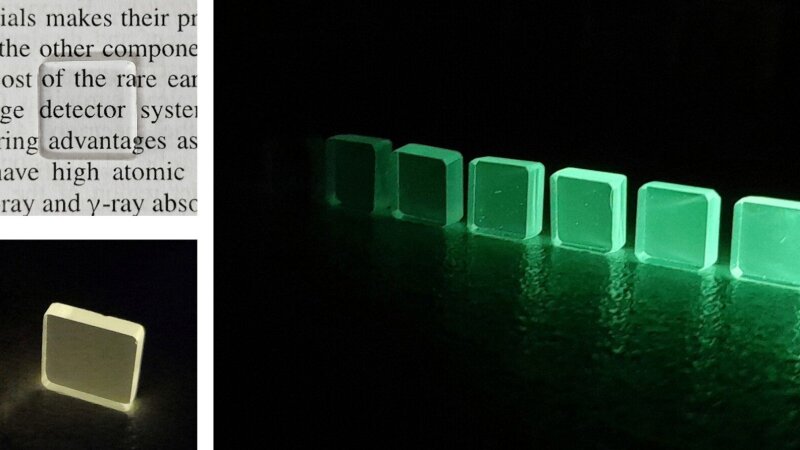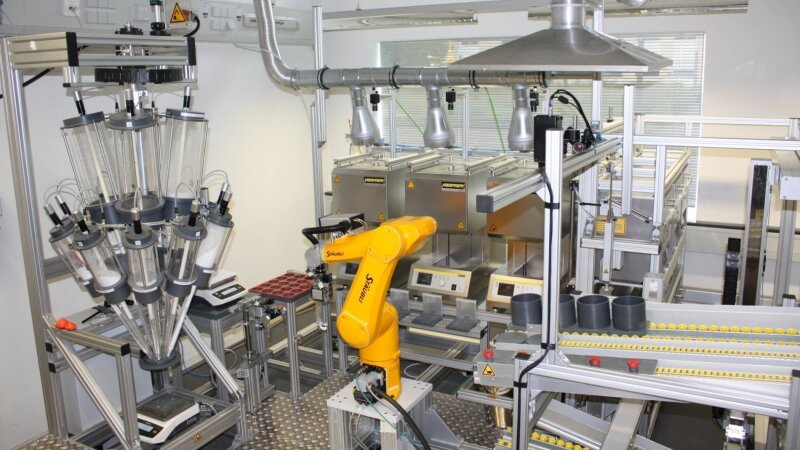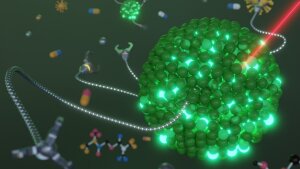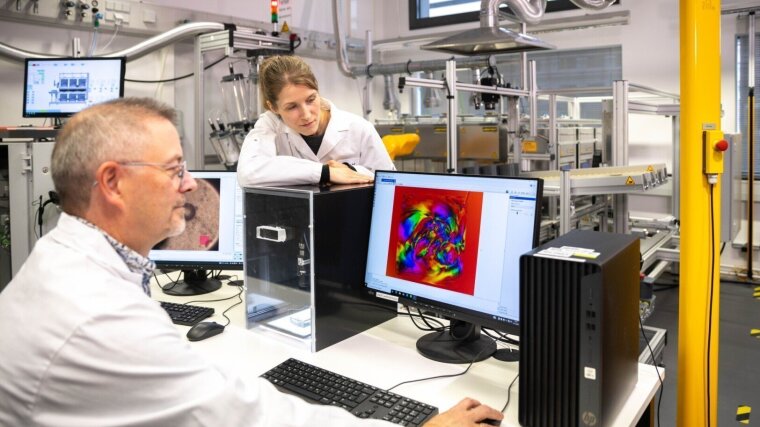
Prof. Andréa S. S. de Camargo
Image: PrivateProf. Dr. Andréa S.S. DE CAMARGO
Email: andrea.camargo@uni-jena.de
Phone: +49 30 8104-1560
Quantum Dots
Image: Pedro F. G. M. da Costa, USPProf. Andréa de Camargo holds the chair of Data driven Glass Science at the Otto Schott Institute of Materials Research (OSIM) at the University of Jena and is the head of Division 5.6 – Glass, at the Federal Institute for Materials Research and Testing (BAM) in Berlin since 2023. Previously, she was a professor at the University of São Paulo (USP) in Brazil. She is an editor of the J. Materials Science (Springer Nature), advisory board member of the J. Non-Crystalline Solids (Elsevier), and a member of the Technical Committee 20: Photonic glasses and optical fibers of the International Comission on Glass (ICG).
Research Areas
The research focus of Prof. de Camargo´s group is on the design, synthesis, characterization, and structural-property correlation of optical and luminescent single/composite materials with applications such as lasing, solid-state lighting, thermal and chemical sensing, scintillation, solar conversion, and theranostics. Past and current research topics include:
- Oxide and oxyfluoride glasses and glass ceramics doped with trivalent rare earth ions and/or containing plasmonic metallic nanostructures, or crystalized semiconductor phases. Studied compositions include multicomponent glasses with greatly improved mechanical properties.
- Phosphor in glass (PiG) composites: Luminescent/persistent luminescent silicates, alumino-silicates, fluorides, etc., embedded in oxide (silicates, phosphates) glassy hosts.
- Inorganic or hybrid host-guest sol-gel materials: Mesoporous silicate or organo-silicate hosts incorporated with highly luminescent dyes and triplet emitting organometallic complexes.
- Nanoparticles: Core-shell infrared-to-visible upconversion (naked or target-functionalized), semiconductor quantum dots, plasmonic nanostructures, Pb-free double halide perovskites.
Fluorescent glasses.
Image: Thiago A. Lodi, USPTeaching Fields
Prof. de Camargo has been teaching under- and graduate courses of Chemistry and Materials Science in the fields of:
- General and Inorganic Chemistry
- Solid state spectroscopy (Vibrational, Optical, Magnetic Resonance)
- Functional (nano)materials synthesis and characterization
Robotic glass melting system at BAM.
Image: De Carmargo Research Group at BAM, BerlinResearch Methods
Prof. de Camargo´s group provides diverse methodology and expertise in synthesis, processing, and characterization of bulk and nanostructured materials.
Synthesis and processing
- Glass melting furnaces; Automated robotic glass melting system.
- Pressure chamber/furnaces for thermal treatments (gas flow, vacuum, glove box)
- Powder processing: high-energy planetary ball mills (dry, wet), sieving, mixing, rheometer.
- Heating microscope (shrinkage); Heating stage microscope (in situ crystallization)
- Setups for solution and sol gel synthesis (glove box, rotary evaporator, spin/deep coating)
Thermal analysis
- Rotational viscometry; Dilatometry (horizontal and vertical)
- Thermobalances with simultaneous DSC or DTA; Large thermogravimetric analyser
- Dynamic-mechanic thermal analysis; Rheometer, particle size analysis
Structural and microstructural analysis
- X-ray diffraction, MEV and TEM microscopy (available at Dept. 6 – BAM)
- Laser scanning and light microscopy
- Vertical dilatometry; IR spectrometry (microscopy); Pycnometry (density)
- Mechanical analysis: Resonance frequency damping analysis (RFDA, E, G, µ), double cantilever beam (DCB, crack propagation), Vickers indentation
Spectroscopic characterization
- UV-Vis-NIR spectrometry
- High resolution NMR spectroscopy (available in Dept. 6 - BAM)
- Steady state and time resolved Photoluminescence; quantum yields (in Dept. 1 - BAM)
Recent Research Results
Optical Glasses for sensors and IR photonic devices
When it comes to optical applications of glasses doped with emissive trivalent rare earth ions (RE), the chemical environmental of the ions will have a direct influence on the radiative/non-radiative emission probabilities. The vibrational features and chemical nature of the bonds in the first coordination sphere of the ions can be tailored, to some extent, based on structural information given by magnetic resonance (NMR and EPR) techniques associated to vibrational (Raman) and photophysical characterization. For the past 5 years, we have been interested in the development of high-density fluoride-phosphate glasses as UV and X-ray scintillators. The targeted glasses offer a less hygroscopic fluoride environment with lower phonon energy for the RE ions whereas the phosphate network provides improved mechanical and chemical stability. Different sets of glasses, based on Al, In and Ga fluorides, were investigated, using Sc3+, Y3+, Eu3+ and Yb3+ as structural probes. Results show that the desired RE coordination by F, at a given F/P ratio, is proportional to the atomic mass of M (In> Ga> Al) and are nicely corroborated by observation of decreased intensity of vibronic bands and significant increase in the excited state lifetime values of RE dopants. Radioluminescence studies of Ce3+ and Tb3+ doped glasses yielded intense emissions in the blue and green, compatible to UV and X-ray detectors. Recently, we have extended the studies to Ga-based glasses doped with Nd3+ and Ag+ to explore interaction of the RE ion with Ag species (ions, dimers, trimers, nanoclusters, and NPs) upon heat-treatment or femtosecond direct laser writing (DLW) the glasses. Results indicate favourable energy transfer from ionic and molecular Ag species to Nd3+ and ongoing studies evidence plasmonic enhancement of the ions infrared emission by Ag nanoparticles.
Nanoparticle graphics.
Image: Marylyn S. Arai, USPUpconversion Nanoparticles for sensing
Upconversion nanoparticles (UCNPs) which convert infrared radiation into visible/ultraviolet light, have emerged as one of the most powerful tools in the field of chemical, physical and biological sensing. Using UCNPs in fluorescent sensors allows non-invasive, highly sensitive, and selective detection methods, which are particularly beneficial in environments requiring minimal interference and high precision for analytes that can range from metallic ions to biomolecules. Our recent contributions to this field include: (1) development of functionalized Er3+ and Tm3+ doped UCNPs for portable detection of acute kidney injury biomarkers in urine samples via Enhanced Luminescence Lateral-Flow Assay (ELLA); (2) a multifunctional nano-platform that combines Tm³⁺-doped UCNPs with a Cu(I) complex for applications in oxygen sensing, optical thermometry, and emission colour tuning via Luminescent Resonance Energy Transfer (LRET); (3) a novel UCNP-based sensor for Gram-(+) and Gram-(-) bacteria detection and differentiation. In the last, by functionalizing UCNPs with antibiotics - vancomycin for Gram-positive and polymyxin-B for Gram-negative bacteria - and using gold nanoparticles as intensity quenchers, this sensor leverages a ratiometric "turn-on" mechanism for detection. It effectively distinguishes between the two types of bacteria, with excellent concentration correlation across a broad range, making it a promising lower-cost candidate for clinical and environmental diagnostics, as to allow taking rapid measures against bacterial infection.
[1] Gaddam et al., J. Am. Ceram. Soc. 107, 8624 (2024).
[2] Lodi et al., J. Non-Crystal. Solids 603, 122097 (2023).
[3] Galleani et al., J. Phys. Chem C 123, 31219 (2019).
[4] Arai et al., ACS Appl. Nano Materials 8(1), 854 (2025).
[5] Arai et al., ACS Appl. Mater. Interfaces 16, 38243 (2024).
[6] Arai et al., Nanoscale Adv. 3(18), 5125 (2021).
Link to the de Camargo Research group at the Otto-Schott-Institute of Materials Research

